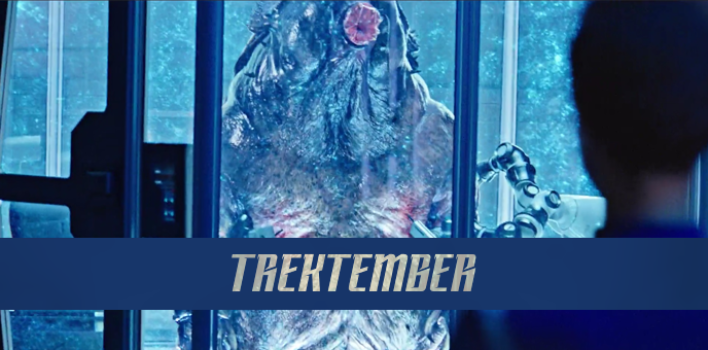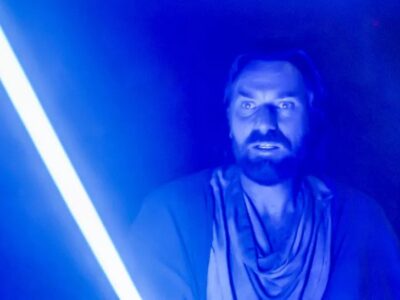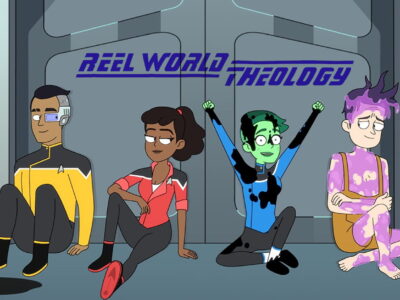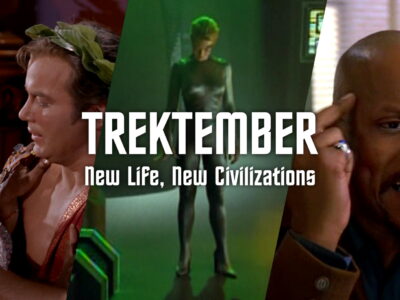Trektember: The Butcher’s Knife Cares Not for the Lamb’s Cry | Star Trek: Discovery
Author’s Note: Star Trek: Discovery is an unusually contiguous series in the franchise. As such, certain ideas and narratives cannot be discussed fully within the bounds of a single episode. For the purposes of this analysis, then, I’m going to be dipping into the next episode, “Choose Your Pain,” in order to discuss how certain important ideas play out.
Recap
Captain Lorca introduces Michael Burnham to the creature that attacked her and her colleagues in the previous episode, and tasks her with weaponizing its features. Meanwhile, an order from Vice Admiral Cornwell to come to the aid of a dilithium mining colony on Corvan II that is under attack by the Klingons forces Lorca to push Stamets into making an unprecedented jump with the spore drive. Meanwhile, Klingons L’Rell and Voq debate the implications of stealing parts from the derelict USS Shenzhou in order to save their own ship and crew.
Review
This was the episode wherein I truly fell in love with Star Trek: Discovery. I had greatly enjoyed the first three episodes, but I really began to feel more at home with the series in “Butcher’s Knife.” It features the kind of thematically and ethically complex writing I’m used to from Star Trek, with perhaps a bit more clarity about the series’ philosophical core.
The episode maintains the tension, uncertainty, and mystery that have defined the series thus far, but begins more directly working through essential Star Trek ideas. In particular, Captain Georgiou’s bequeathal of her telescope to Burnham is a beautiful reminder of the centrality of exploration and curiosity, even in the midst of war—an idea that is at the heart of Michael’s struggle throughout the episode.
The narrative pivots constantly on two major themes—war vs. exploration and compassionate action—while remaining as dense and complex as any episode so far. And that’s just on the human side of things. The Klingon story deserves another blog post altogether. Yes, these Klingons are very different in many ways, but they are still Klingons: well-researched and richly articulated.
Certainly, there are aesthetic, technological, and other issues regarding this series that can be debated, as there have been with every other iteration of Trek that has introduced major shifts and changes into the franchise–including The Motion Picture, The Next Generation, Deep Space Nine, Enterprise, and the Kelvin Timeline. But, as with each of those sets of changes, the ones introduced here represent the creative freedom and focus on cultural relevance that has allowed for the stories contained therein to be written. And in that department along with many others, this is just excellent Star Trek.
Reflection
One of my personal favorite titles in Star Trek, “The Butcher’s Knife Cares Not for the Lamb’s Cry” is the second longest episode moniker in franchise history. Coming in at 48 characters, “Butcher’s Knife” is just two shy of the 50 characters in the Original Series episode title, “For the World is Hollow and I Have Touched the Sky.” However, those two additional characters are spaces; each title contains 40 letters.
And no, I’m not going to discuss the biblical significance of the number 40.
What is significant about the title, though, is that it reflects perhaps the most vital theme of the episode: Compassion. While the ideological struggle of the story, in classic Star Trek fashion, centers around the push and pull within Starfleet between war and exploration (symbolized, respectively, by Lorca’s weapon collection and Georgiou’s telescope). The working out of that theme has to do with how our characters exercise compassion, most notably with reference to the tardigrade creature.
From Burnham’s first non-violent encounter with the tardigrade, she chooses concern and curiosity over fear, even after the creature kills Commander Landry. It is, in fact, Landry’s commitment to follow Lorca’s warfare-focused agenda, in contrast to Burnham’s bent toward exploration, that causes her to lose her life. While Landry sees the tardigrade as a monster, Burnham refuses to judge it by, in her words, “its appearance and a single incident from its past.” Hence, while Burnham is slow to act and eager to study, Landry lunges forward, seeking confrontation with the creature.
Interestingly, though, compassion is also a catalyst for Landry’s choices. When Lorca plays the distress call from the mining colony on Corvan II shipwide as motivation for the crew—especially Stamets, following his heated disagreement with the captain over proceeding with using the spore drive—an unintended result is that Landry decides she’s not wasting any more time and will take the risk of confronting the tardigrade directly. While her clear compassion for the people under attack on Corvan II rightly motivates her to action, the action she takes is unwise and leads to her demise.
At the same time, as Lorca clearly plans, that compassion for the “lamb’s cry” of those being “butchered” by the Klingons on Corvan II also motivates Stamets to continue working to improve the spore drive. Lorca’s decision to play the Corvan II recording, while a typically manipulative move for the captain, demonstrates that he too is operating out of a sense of compassion. Lorca wants to save lives and he knows his crew does as well. In this way, he motivates his crew to action by focusing on their commonly held goals and values.
Even if there is a dissonance between Lorca’s tactical perspective (“I study war,” he tells Burnham) and the commitment to science and exploration shared by Stamets and the crew of the Discovery, they all ultimately seek the same thing: to end suffering and save lives.
Compassion is an essential virtue, but we must choose wisely the actions we take on its behalf. Rooted as it is in strong emotions (see the “passion” part of the word), compassion has the ability to compel us toward ill-advised action.
The need for balance between emotion and logic (another thematically essential Star Trek exploration of duality) is demonstrated in the contrast between Burnham and Landry, in the same room, with the same animal and the same tools, making two vastly different decisions. While Burnham’s Vulcan training holds her back from rash action, Landry’s lack of discernment brings her to a tragic fate.
The theme of compassion continues in “Choose Your Pain,” as Saru must also balance compassion for the tardigrade with compassion for Captain Lorca, making the difficult decision to engage the spore drive, even though it means further harming the animal.
Compassion again comes into play, however, as Stamets sacrifices his own safety and potentially his life, injecting himself with the tardigrade DNA and using his own body instead of the creature’s as the spore drive’s navigation system. His actions save the tardigrade and the people remaining on Corvan II. Even still, the closing shot of “Choose Your Pain” indicates that there may be lasting consequences for Stamets.
Compassion alone is never enough. It must be paired with wisdom and discernment, seeking right action rather than using the motivation of compassion as a justification for any action we wish to take. “The Butcher’s Knife Cares Not for the Lamb’s Cry” is a deft and complex exploration of the many forms compassionate action may take and the ethical judgments involved therein. Even when our actions result in their intended goal, the unintended fallout of our decisions can still have a harmful effect. It may therefore be required of us to alter our course.
It is Burnham’s compassion for the tardigrade that leads her to solve the mystery of the creature’s role in the spore drive. But as the tardigrade story concludes in “Choose Your Pain,” it is that same compassion, listening to the “lamb’s cry” of the suffering tardigrade, that causes her to push against further use of the drive and ultimately to set the tardigrade—the lamb—free.
Jesus, the Lamb of God, also needed compassion as, with his own cry on the cross, he asked God, “Why have you forsaken me?” As with the example of Stamets’ self-sacrifice in this episode, it was also his compassion for humanity that motivated him to willingly embrace suffering and death. And ultimately, God shows his compassion on us all because of the cry of Jesus, the Lamb, asking God’s forgiveness for his butchers, even as he felt their knife.
The butcher’s knife cares not for the lamb’s cry, but even as those butchers failed to show compassion for the Lamb, even as we butcher compassion in the Lamb’s name, God’s compassion for us is never-ceasing, suffering along with us because of Jesus. So, we cry out for compassion, knowing that God does not wield a knife, but bore the wounds of our knife that we might be set free.
• • •
Trektember is an annual series about Star Trek; this year, we’re examining the first seasons of Star Trek: Discovery and The Orville. For more information on this series, click here; or, to read every article from the beginning, click here!








Pingback: Trektember: Season 3 Episode List | Reel World Theology